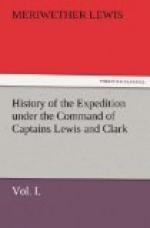In the meantime we proceeded, and in the course of eleven miles from our last encampment passed two small islands, sixteen short round bends in the river, and halted in a bend towards the right where we dined. The river increases in rapidity as we advance, and is so crooked that the eleven miles, which have cost us so much labour, only bring us four miles in a direct line. The weather became overcast towards evening, and we experienced a slight shower attended with thunder and lightning. The three hunters who were sent out killed only two antelopes; game of every kind being scarce.
Saturday, 10. Captain Lewis continued his route at an early hour through the wide bottom along the left bank of the river. At about five miles he passed a large creek, and then fell into an Indian road leading towards the point where the river entered the mountain. This he followed till he reached a high perpendicular cliff of rocks where the river makes its passage through the hills, and which he called the Rattlesnake cliff, from the number of that animal which he saw there: here he kindled a fire and waited the return of Drewyer, who had been sent out on the way to kill a deer: he came back about noon with the skin of three deer and the flesh of one of the best of them. After a hasty dinner they returned to the Indian road which they had left for a short distance to see the cliff. It led them sometimes over the hills, sometimes in the narrow bottoms of the river, till at the distance of fifteen miles from the Rattlesnake cliffs they reached a handsome open and level valley, where the river divided into two nearly equal branches. The mountains over which they passed were not very high, but are rugged and continue close to the river side. The river, which before it enters the mountain was rapid, rocky, very crooked, much divided by islands, and shallow, now becomes more direct in its course as it is hemmed in by the hills, and has not so many bends nor islands, but becomes more rapid and rocky, and continues as shallow. On examining the two branches of the river it was evident that neither of them was navigable further. The road forked with the river; and captain Lewis therefore sent a man up each of them for a short distance, in order that by comparing their respective information he might be able to take that which seemed to have been most used this spring. From their account he resolved to choose that which led along the southwest branch of the river which was rather the smaller of the two: he accordingly wrote a note to captain Clarke informing him of the route, and recommending his staying with the party at the forks till he should return: This he fixed on a dry willow pole at the forks of the river, and then proceeded up the southwest branch; but after going a mile and a half the road became scarcely distinguishable, and the tracks of the horses which he had followed along the Jefferson were no longer seen. Captain Lewis therefore returned to examine the other road himself, and found that the horses had in fact passed along the western or right fork which had the additional recommendation of being larger than the other.




